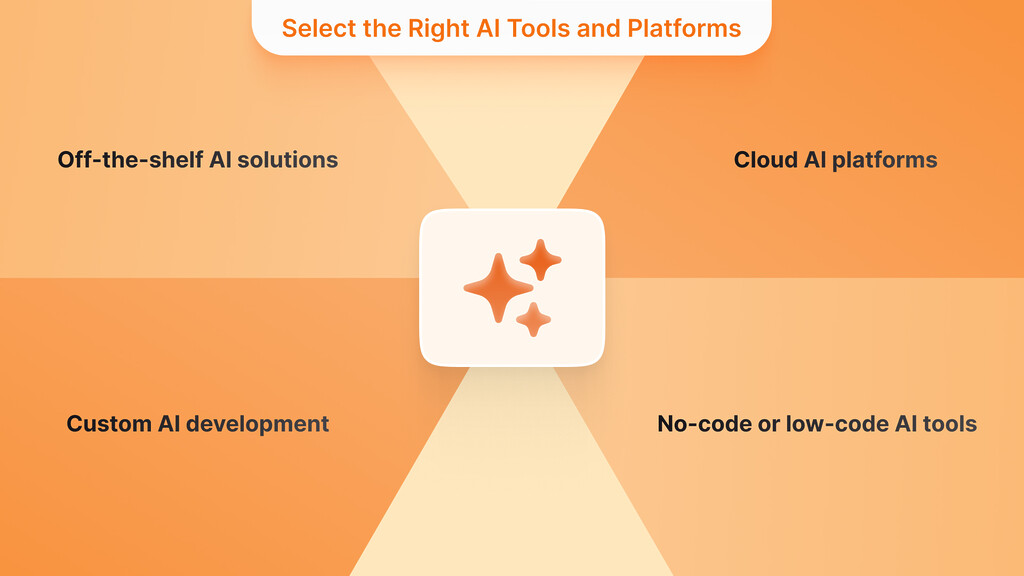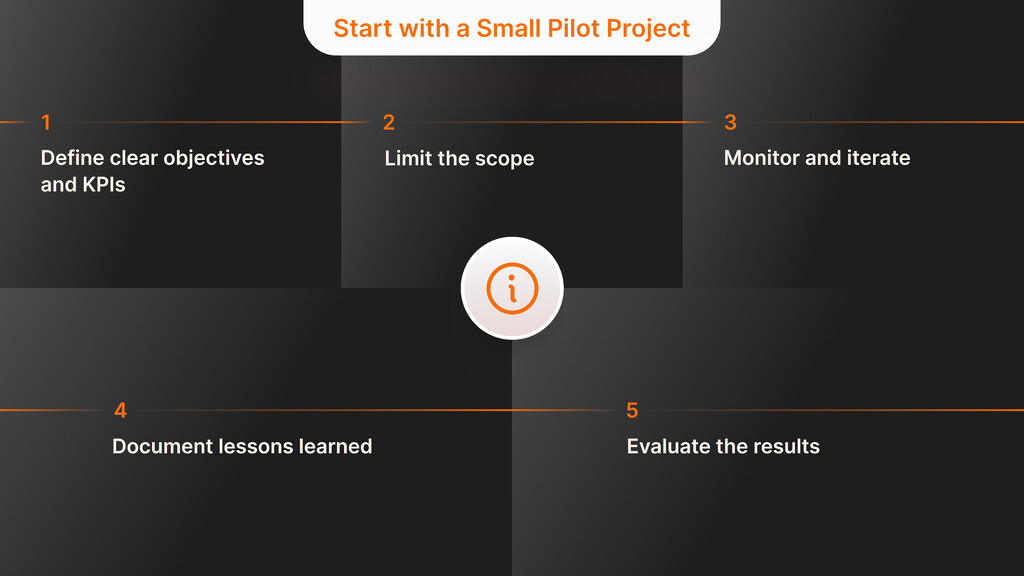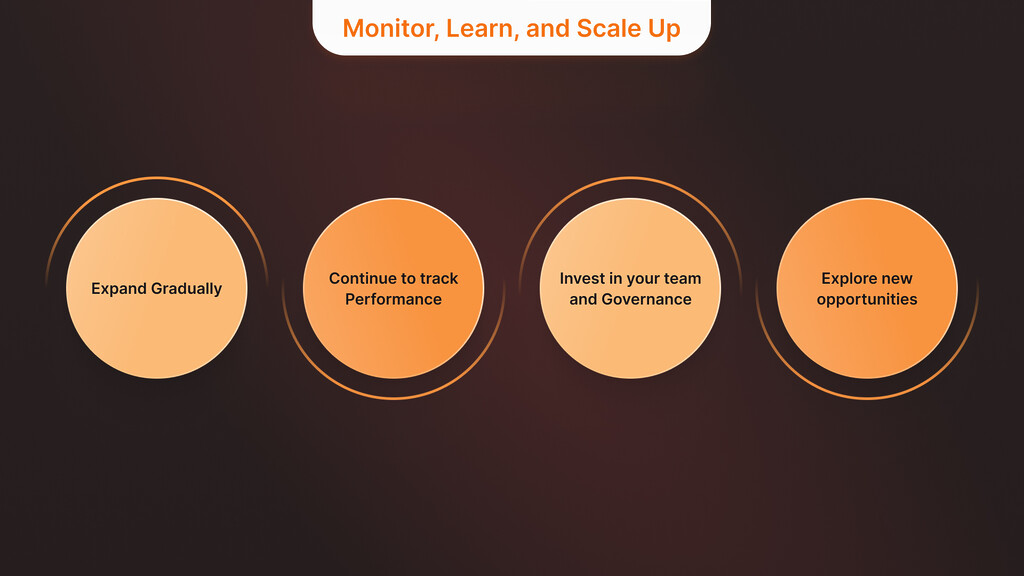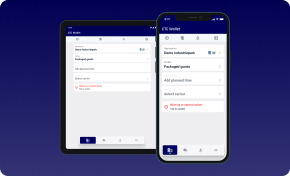AI integration is now mission-critical for businesses of every size, driving measurable gains in revenue, efficiency, and competitiveness. A recent survey shows 91 % of small and mid-sized companies that adopt artificial intelligence report higher income, while McKinsey research finds 78 % of organisations already applying AI in at least one function.
Because the technology delivers rapid ROI—from automating routine tasks to sharpening data-driven decisions—implementing AI has shifted from “nice to have” to strategic necessity. This guide walks you through the process step by step: identifying high-impact use cases, auditing data readiness and skills, selecting the right tools, and running a low-risk pilot that proves value fast. By following these best practices, both lean startups and large enterprises can launch AI initiatives with confidence and position themselves for sustainable, scalable growth.
Identify High-Impact AI Use Cases
The first requirement is to locate specific areas within your business operations where AI solutions can generate substantial value. Only implement AI technologies when they serve concrete problem solutions or improve essential processes. You should begin with use cases that connect to your business objectives and deliver concrete results that can be measured. To find suitable AI applications, examine those sections requiring time-saving automation and predictive modeling capabilities that could enhance decision-making processes. AI should serve business needs directly while avoiding the status of an experimental project. Several well-documented applications of high-impact AI systems exist in modern business practices.
- Streamlining administrative work requiring repetitive actions, such as data entry, reporting, and invoice processing, allows employees to gain additional time.
- Implementing AI-powered virtual support systems enables 24/7 FAQ management through chatbots, enhancing both support times and customer satisfaction.
- Implementing machine learning techniques allows organizations to conduct better data analysis for forecasting and analytics, which results in enhanced decision-making abilities.
You should concentrate on AI projects delivering specific return on investment benefits, including cost reductions, revenue growth, and customer loyalty improvement. Starting with one to two carefully selected projects will create momentum so stakeholders recognize AI’s value to the organization.
Making Product Discovery Clear and Accessible
Transform Concepts into Products in Four Weeks with Our Proven TechBoost Program
See Product Discovery ServicesEvaluate Your Data Readiness (and Skills)
Before applying AI, evaluate your business readiness by examining its data availability and skill capacity. AI requires data to operate effectively, so you must verify the suitability and quantity of your available data to use with your selected application. Ask yourself:
- Do we possess sufficient data that suits this particular use case? Extract all necessary data an AI model requires from your systems, databases, or customer-facing operations. You should start collecting needed data or employ pre-trained models that work efficiently with minimal data.
- Is our data of high quality? Verify that your data contains no errors while maintaining accuracy, thoroughness, and uniformity. The use of poor data leads to unreliable AI outputs. Implementing AI requires you to first clean or improve existing data collection systems.
- Do our current data infrastructure and data access meet requirements? The IT infrastructure must be capable of executing AI workloads. The deployment requires cloud storage and computing resources to support model training activities and AI service operations. Your AI initiative’s deployment will stay smooth when you implement scalable cloud systems with enough storage/network capacity.
Your organization should examine the skill capabilities of its team members in addition to data assessment. AI depends on human operators to determine its success rate. Does your organization have team members who know data analysis techniques and fundamentals of machine learning? Make arrangements to overcome any existing shortcomings. Training current staff members together with hiring external experts appears to be a solution to consider. 63% of SMB employees lack sufficient preparation to use AI tools, highlighting the importance of skill enhancement initiatives. The company must establish workshops for AI literacy education or hire a data scientist and seek guidance from an AI service provider. Your early assessment of technical and data readiness and human preparedness provides a strong base, preventing future obstacles from appearing.
IT Consultancy for Strategic Advantage
Tailored IT Solutions to Drive Your Business Forward
Discover IT ConsultingSelect the Right AI Tools and Platforms

The next step requires selecting platforms or tools that will allow you to implement your AI project following the identified use case and accomplished data preparation. The broad spectrum of AI solutions requires businesses to select tools that match their operational requirements, financial constraints, and technology limitations. There exist three different options for consideration:
Off-the-shelf AI solutions
Small and medium businesses find it simplest to adopt ready-made artificial intelligence software and services as their AI solution. Multiple SaaS solutions exist for business use, including website chatbots, AI analytics services, and AI-enabled CRM systems. You can start AI implementation in customer service and analytics, along with productivity and more, through off-the-shelf tools that provide affordable access to user-friendly solutions without extensive customization.
Cloud AI platforms
The leading cloud service providers, including Amazon AWS, Google Cloud, Microsoft Azure, and others, supply their customers with AI and machine learning platforms. These platforms offer AI services, natural language processing APIs, and image recognition capabilities, and provide infrastructure for training custom models. Cloud platforms also have scalability features and payment approaches based on actual usage, so users can easily try new solutions. The platform enables integrations between cloud data storage and existing cloud applications.
Custom AI development
Building your own proprietary AI becomes the right choice if your organization has particular needs or wants to gain a competitive advantage through AI. Building models involves using TensorFlow or PyTorch frameworks and other such tools. Businesses that maintain trained technology teams tend to use this approach for their important strategic initiatives. Developing custom solutions takes expertise, extended time commitment, and monetary investment. Companies with outgrown basic AI systems can combine their proprietary solutions with commercial third-party software products.
Custom Software Perfectly Aligned with Your Strategic Objectives
Software Solutions that Fit and Enhance Your Business Strategy
Explore Custom SoftwareNo-code or low-code AI tools
The market now provides various platforms that help users implement AI functionality while reducing the need for coding. Such tools, including automated machine learning services and drag-and-drop model builders, reduce entry barriers for organizations lacking specialized developers. Users without programming expertise can train models while making automated decisions using these tools through graphical interfaces.
A tool selection process must consider integration capabilities along with scalability factors. To minimize user inconvenience, the AI solution requires connecting to current workflows or software through API or plugin integration. Ensure the tool fulfills your sector’s mandatory security and compliance standards during data handling operations. The selection process involves assessing both solution value and budget limitations, so begin with tools offering affordable benefits. Small to medium-sized businesses should examine affordable cloud service trials or use existing software rather than spend money on expensive infrastructure startup costs. Enterprises must ask their IT and procurement specialists to assess how a platform will grow to support organizational needs. Selecting appropriate tools will facilitate easier AI integration along with sustainable operational success.
Start with a Small AI Pilot Project

The immediate implementation of AI across all areas should be avoided when you have use cases, necessary data, and tools. A little pilot project should be initiated first to assess feasibility. AI solution testing through piloting occurs when you deploy your AI system at a restricted level, such as one department or with a small dataset, to verify usefulness before deploying to larger audiences. This method helps decrease potential risks while it shortens the time needed to understand things. Success in running an AI pilot requires these sequential steps:
Define clear objectives and KPIs
Set precise objectives together with KPIs to determine how your pilot will succeed. Improving customer response time by 30% while reducing processing costs can be one of your goals. Your organization must establish specific performance measurement indicators that serve as key performance indicators. Business results, including higher sales numbers and reduced customer mix, will demonstrate the value of the AI project when you connect the KPIs to these outcomes.
Limit the scope
The pilot project needs to stay focused on its specific objectives. The AI-powered chatbot should be deployed to serve one specific product range independently, while machine learning should focus on improving a single process step. Handling problems and resolving issues becomes simpler when the project includes focused objectives. The experimental zone contains all adverse effects from mistakes, which safeguards the rest of your operations during your test phase.
Monitor and iterate
Track performance continuously, together with gathering user feedback throughout the pilot phase. Regular monitoring of your KPIs is essential to verify whether the AI systems are giving you the desired results, and you should do this assessment at least once weekly. Request feedback from personnel who work with the AI system because they may discover unanticipated system results or performance problems. The system should be improved based on these gathered insights. AI implementation follows an iterative approach, which requires modifying variables and workflow patterns and possibly reforming data entry methods as you learn from pilot tests.
Document lessons learned
The pilot stage should be a platform to document all acquired knowledge. The success factors and encountered obstacles became clear. The AI model delivered accurate results, yet working with your database system proved challenging, while employees required additional training than forecasted to use the new tool. Capture these lessons. The information you collect during the pilot will serve you well when you expand the initiative or move on to your next AI program.
Begin Your Digital Transformation Journey
Customized Strategies to Lead Your Business into the Digital Age
Explore Digital TransformationEvaluate the results
Assess the program after the agreed duration of operation. The set of success criteria was reached. Determine the ROI rate to see whether the time and cost benefits surpassed the funding amount. Your business case for AI expansion and leadership support becomes available when the pilot achieves or exceeds its targets. Analyze the reasons behind why the pilot failed to meet its targets. The pilot phase allows organizations to detect model inadequacy, lack of proper data, or mismatched AI suitability before implementing across the entire system.
The initial modest implementation allows your organization to validate an AI application within its specific operational environment. This approach develops stakeholder and team member confidence because it creates vital momentum for future enterprise AI implementation throughout the organization. A readiness checklist suggests that businesses should launch a pilot project before expanding it when they notice positive outcomes.
For implementation tips, check out 5 Proven Steps to Embark on a Digital Transformation and Guide to Successfully Running a Soft Launch.
Monitor, Learn, and Scale Up

Organizations must precisely execute their AI scaling efforts after finishing a successful pilot project. The expansion process should follow a planned approach using learnings from the pilot stage. The AI solution should now be integrated into operational frameworks or deployed across more divisional units and application areas. The successful AI chatbot pilot for a single product line should transition to all product lines while reaching various customer service channels. As you scale:
Expand Gradually
A sudden implementation of enterprise-wide AI across the entire organization should be avoided. Phase-based implementation is more effective when functions or departments are added step by step. The stepped implementation schedule enables you to handle organizational changes while conducting troubleshooting activities at a sustainable rate. The implementation allows staff members to adjust their understanding of new tools and procedures.
Continue to track Performance
Scaling up doesn’t mean set-and-forget. Track the defined KPIs to verify that AI maintains its value delivery as your business expands. Implementing AI creates opportunities to establish fresh performance indicators after deploying chatbots across the organization. AI implementation follows an iterative process, so organizations need to adopt continuous optimization as their primary mindset. Regular assessment of AI projects should validate their alignment with business objectives and return on investment during your company’s expansion.
Invest in your team and Governance
Organizations will need additional training and stronger governance systems to achieve broader adoption. All staff members should learn about their organization’s AI tools, since complete data science skills are not needed, yet universal AI knowledge supports user acceptance. Create AI guidelines or policies that show teams the right ways to apply AI and follow ethical AI practices, including handling AI output and protecting data privacy. Enterprises create steering committees that oversee AI strategy and handle any resistance to change across various functional teams. Small businesses can maintain their AI initiative through dedicated AI champions or small monitoring task forces, which will help prevent project deviations.
Development Teams for High-Impact Results
Strengthen Your Initiatives with Our Specialized Software Development Teams
Get Your Development TeamExplore new opportunities
After achieving your first AI milestone, you should develop alternative business applications that will produce significant AI benefits. Your initial marketing project may lead to supply chain optimization through artificial intelligence and machine learning for quality assessment. Apply the established momentum and organizational knowledge to take on new projects while maintaining the disciplined approach from the beginning (value identification and data preparedness) for every new initiative.
AI’s real transformative power becomes apparent when used to upscale your business operations, provided you approach it deliberately. Implementing small AI wins through gradual expansion and continuous learning will help your entire organization improve. The process will convert your experimental AI-driven operations into crucial organizational elements integrated into operational and strategic realms.
Embrace AI as a Continuous Journey
Starting with AI implementation leads to profitable outcomes because you need proper objectives and organized strategies before you begin. AI integration for businesses becomes easier and brings significant returns by choosing high-priority areas, preparing data platforms and teams, selecting proper tools, and starting with modest priorities. When applying AI within smaller businesses or at an organization-wide enterprise level, the fundamental rules remain unchanged, which include delivering business value through preparation investments and continuous development improvements. Businesses embracing AI integration effectively become more competitive during this AI-driven era, since those who delay face risks of falling behind their competitors.
You need to initiate your AI journey with an initial small move in the present day. AI pilot implementation, combined with the proper strategy and business mindset, leads to valuable business insights, which launch your organization into AI-driven expansion. AI-powered business operations will unite with human work, so companies should start building their fundamental systems right now. Implementing AI technology will establish your business as a leader, ensuring long-lasting business success and resilience.
Explore long-term strategies in Leveraging Technology to Scale Your Startup and Edge vs Cloud Computing: Optimal IT Solutions for Business.
Ready to explore what AI can do for your business? Contact us today to schedule a consultation tailored to your unique goals.
What is AI integration in business?
AI integration refers to incorporating artificial intelligence technologies, such as machine learning, automation, and natural language processing, into existing business processes. It enables companies to automate routine processes, make smarter decisions, and uncover data-driven knowledge.
Why is AI important for SMBs and enterprises today?
AI is a game-changer for operational efficiency, customer experience, and innovation. Research indicates that 91% of SMBs using AI report increased revenue. For enterprises, AI enhances agility and minimizes costs, providing a competitive advantage in already crowded markets.
Where should we start with AI in our company?
Start with 1-2 business processes where AI can generate immediate value, such as support ticket automation or sales prediction. By beginning with use cases, teams and leadership can stay focused, minimize risk, and build confidence.
What types of problems can AI solve in my business?
AI can automate manual processes (such as data entry and scheduling), provide personalized customer communication, identify fraud, predict demand, and optimize supply chains. It is most appropriate in situations where the speed, magnitude, and pattern recognition are most important.
Do we need a lot of data to get started?
Not necessarily. Numerous ready-to-use AI tools can operate with small datasets or external models. In the case of custom solutions, however, high-quality data is fundamental. It is preferable to have small quantities of well-organized data, rather than bulk quantities of inconsistent data.
How can we assess if our data is AI-ready?
Enquire whether your data is valid, reliable, complete, and available. That will require a facility to store, retrieve, and process this data. Begin with database audits, duplicate elimination, and the establishment of clear collection standards.
What AI tools or platforms should SMBs consider first?
SaaS-based AI (such as chatbots or CRMs with built-in analytics) should be the first type of AI SMBs adopt. The cloud AI service providers (AWS, Google Cloud, and Azure) have flexible pay-as-you-go pricing. Low-code tools are best for rapid testing with minimal deep-tech requirements.
When is custom AI development a better choice?
Custom AI is a better choice for businesses with unique workflows, compliance requirements, and proprietary data. It provides control and long-term benefits but takes time, budget, and expertise to establish, develop, and support—either in-house or outsourced.
Should we start with a pilot project?
Yes. A pilot assists in testing your case of AI with the minimum of risks. Begin with a small-scale test: a chatbot with one product team, measure the results, collect feedback, and refine before expanding to more individuals or departments.
How long should a pilot project run?
The duration of pilot projects is usually 4-12 weeks. This period enables you to plan, put into practice, test, and gauge performance. Short pilots help you move faster and show you how AI interacts with your processes and people.
What are the key metrics for evaluating AI performance?
Pay attention to KPIs related to your business objectives: cost reduction, response time, error rate, customer satisfaction, or forecast accuracy. ROI is always measurable by operating against pre-AI performance.
How do we scale up after a successful pilot?
Scale incrementally. Expand into other teams or workflows based on the pilot’s understanding. Refresher training, automation, AI into long-term strategy, and IT governance.
What skills or roles are required for AI integration?
AI needs such positions as data analysts, software developers, project managers, and AI specialists. SMBs can upskill current staff and collaborate with AI development partners. The employees who are not technical ought to be aware of how to operate AI tools.
How can we make sure our team adopts AI tools?
Establish credibility through interaction and engagement. Provide training, identify quick wins, designate champions, and make artificial intelligence tools easy to use. Employee feedback is essential to adoption and continuous improvement.
What’s the biggest mistake companies make with AI?
Entering AI without an objective or pure data. Others do not work because of a failure to train users or the selection of incompatible tools. Don’t treat AI as a trend; connect it to actual business problems.










